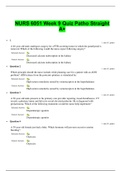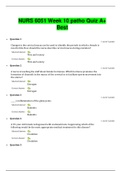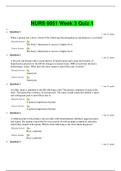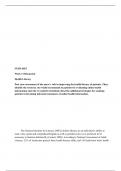Nurs 6051 week 11 - Study guides, Class notes & Summaries
Looking for the best study guides, study notes and summaries about Nurs 6051 week 11? On this page you'll find 25 study documents about Nurs 6051 week 11.
Page 3 out of 25 results
Sort by

-
NURS 6051 Week 9 Quiz Patho Straight A+
- Exam (elaborations) • 8 pages • 2021
-
- $11.99
- + learn more
NURS 6051 Patho Week 9 Quiz 1. A 30-year-old male presents to his primary care provider reporting visual disturbances. CT reveals a pituitary tumor and lab tests reveal elevated prolactin. He is diagnosed with prolactinoma. Which of the following treatments would the nurse help implement? 2. Visual disturbances are a common occurrence in patients with untreated Graves disease. The endocrinologist explains to the patient that the main cause of these complications is: 3. A 12-year-old mal...

-
NURS 6051 Week 10 patho Quiz A+ Best
- Exam (elaborations) • 9 pages • 2021
-
- $9.99
- + learn more
NURS 6051 Week 10 patho 1. A 30-year-old female with newly diagnosed PCOS is being counseled by her OB-GYN. The physician indicates that this condition often results in: 2. When a staff member asks the nurse what the thick middle layer of the uterine wall is called, what is the nurse’s best response? The: 3. During a routine pelvic exam, a 34-year-old female is found to have an ovarian cyst containing skin, hair, cartilage, and bone. This cyst is classified as a _____ cyst. 4. A 21...

-
NURS 6051 Week 3 QuizA+MATERIAL
- Exam (elaborations) • 6 pages • 2021
-
- $10.99
- + learn more
NURS 6051- Pathophysiology Week 3 quiz 1. When a patient has a fever, which of the following thermoregulatory mechanisms is activated? 2. A 15-year-old male is brought to the ER for treatment of injuries received in a motor vehicle accident. An MRI reveals spinal cord injury, and his body temperature fluctuates markedly. The most accurate explanation of this phenomenon is that: 3. A child presents to his primary care provider with disorientation, delirium, aggressiveness, and stupor. Hi...

-
NURS 5051/6051 Assignments with Solutions (Week 1 to 11)
- Package deal • 4 items • 2023
-
- $80.49
- + learn more
1. NURS 6051 Week 3 & 4 Assignment (Using the Data, Information, Knowledge, Wisdom Continuum) 2. NURS 6051 Week 5 & 6 Assignment: Application - Adoption of New Technology System 3. NURS 6051 Week 7 & 8: Assignment Application - Creating a Flowchart 4. NURS 6051 Week 11 Assignment: Application - Health Information Flyer

-
NURS 5051/6051 Discussion with Solutions (Week 1 to 11)
- Package deal • 10 items • 2023
-
- $80.49
- + learn more
1. NURS 6051 Week 11 Discussion: Health Literacy 2. NURS 6051 Week 10 Discussion: Security of Health Care Records 3. NURS 6051 Week 8 Discussion: Using Health Information Technology as a Source of Evidence-Based Practice 4. NURS 6051 Week 7 Discussion: Understanding Workflow Design 5. NURS 6051 Week 6 Discussion: Successful... (Continued)

How did he do that? By selling his study resources on Stuvia. Try it yourself! Discover all about earning on Stuvia


